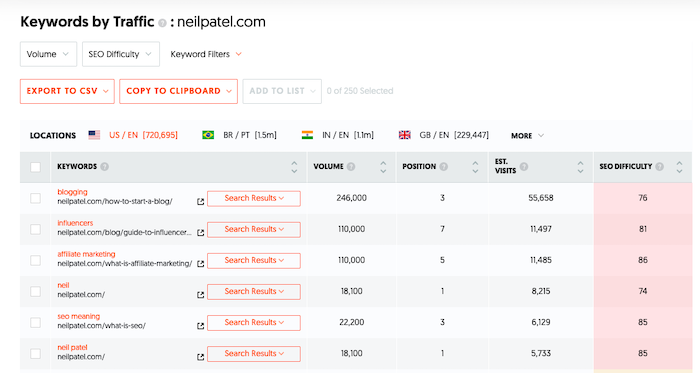
Do you want to migrate your website but are worried about impacting its performance and tanking its rankings?
Website migrations can be useful, but they are never without risk. That’s why it’s important to follow a proven process.
Below, I’ll explain what a website migration entails, draw up a checklist you can use when migrating your website, and explain each step of the process in detail.
If you’re planning to migrate your website, this should be the only guide you need to read.
When you’re ready, let’s get migrating.
What Is a Website Migration?
A website migration is a change to your website that’s so significant it impacts the site’s structure, performance, or traffic.
The most common form of website migration is moving from one domain to another. But transitioning from HTTP to HTTPS and changing your URL structure are also types of migration.
In some events, website migration is necessary for your business and certainly has many benefits, but you need to be careful. You could crash your site, cut your traffic in half, or change your site’s usability so much that revenue falls off a cliff.
Those risks may sound scary, but all of them can be overcome by following a tried and tested site migration strategy—just like the one I will cover below.
Still, you shouldn’t ignore the danger entirely.
Migration has the possibility to derail your site’s performance, traffic, and other metrics, so you need to treat it as a major project and assign the resources (and budget) it deserves.
Website Migration Checklist
Because website migrations can be so complex and challenging, it helps to have a checklist to follow. Use this checklist as a guide when migrating your website, and tick off each step as you go.
- Define why you want to migrate your website.
- Establish measurable objectives and goals.
- Set a budget and timeline for your migration.
- Start assembling your team.
- Draw up a marketing plan to promote your new site before launch.
- Put a content freeze in place.
- Crawl your existing site, and create a repository of all your pages.
- Create a 301 redirect plan that maps your existing content to your new site as accurately as possible.
- Run tests in a closed environment to check that redirects work and pages load as expected.
- Work out how you will track the success of your migration.
- Execute the migration.
- Track the impact of your migration for a year and make improvements as required.
Now you know what to expect, let’s cover each step in more detail below.
How to Do a Website Migration
Below, I’ll cover all of the checklist steps in more detail. I recommend reading through the advice before getting started with your website migration.
1. Define the Goals of the Website Migration
Start your process by defining why you are migrating your site and what it will look like. Do you need to transfer the entire site to a new domain name, or will it only affect a portion of your current site?
There are many reasons for a website migration, including:
- moving from HTTP to HTTPS
- reaching a wider audience with a better domain
- taking your site international
- increasing search traffic
- improving your site’s design
By defining your reasons for a site migration, you can draw up a set of sensible objectives and goals.
For instance, if you’re moving your site to HTTPS, an objective may be to retain traffic levels. On the other hand, you may want to grow traffic if you’re moving to a .com domain for the international reach.
It will also help you to plan better going forward. As John Mueller says, everyone’s heard a migration horror story. You don’t want to create a new one.
The best solution is to be as diligent and prepared as possible.

Speak to as many people inside and outside your business as you can. IT experts, SEOs, designers, analytics teams; they’ll all have invaluable opinions and advice on how to get it right—but also explain what can go wrong.
2. Set Website Migration Budgets, Timelines, and Teams
Now you know what you’re trying to achieve and why, it’s time to create a website migration plan that includes:
- a sensible budget
- a timeline
- the teams and their responsibilities
Having a clearly defined strategy is crucial. Your website migration won’t happen in a day. It’s a complex process with several moving parts and requires great communication between different team members to achieve success.
Your timeline will be easy to create once you’ve read this entire article. Just break down all of the steps in this list into deliverables, assign them to relevant teams and set realistic deadlines. Draw this up in a project management tool like Wrike, Trello or Asana so that everyone can communicate and collaborate in one space.

A cross-department team will have the best chance of success. System admins, developers, SEOs, designers, UX developers, copywriters, and more will all have a part to play in a successful migration, so make sure everyone has a seat at the table.
Finally, when creating a timeline, know that there will almost certainly be a period of downtime due to your migration. That’s why it’s best to schedule migrations during periods of low traffic (such as late at night) to limit the number of visitors affected.
Assuming you have the right skills in-house, a website migration shouldn’t require a huge amount of budget. There are several tools I’ll cover below that can streamline the process, but they aren’t that expensive.
Nevertheless, it’s best to fence off a contingency budget if the worst happens and your migration runs into problems that only an expert consultant can solve.
3. Promote Your New Website Before the Website Migration
One of the hardest parts of a site migration is getting everyone to understand your site has moved. A 301 redirect will make sure outdated links aren’t a complete waste, but they will lose impact and confuse customers if they remain outdated for long.
It’s relatively simple to tell Google that you’ve changed URLs, but it’s a lot harder to get the message across to your customers. That’s why the best migrations include a pre-migration promotional campaign that teases the new URL to customers and gets everyone on board with the move before it happens.
There are several ways you can do this. Start by creating a coming soon page on the new URL while working on the background migration. Promote the new URL using email and social media to customers and the press. The more buzz you build before launch, the smoother the migration will be.
Take care not to lose out when people still search for your old URL or brand name, either. Create a page on the new site that will rank for your old brand name and explain the move. Set up PPC ads on Google to rank for queries related to your old name or URL. Paid campaigns targeting your new brand name can also limit the fall in traffic that may occur directly after the migration.
4. Pull All Website URLs From Tools for the Website Migration
The vast majority of migrations will involve changing URLs. If this isn’t the case for you, you can skip this and the following step. If not, roll up your sleeves because this is where things get serious.
It starts with creating a content map.
Before you can go ahead and migrate your site, you need a complete picture of all your content. This will allow you to see which URLs need to be directed, which don’t and where’s best to point them. Creating a content map will also highlight existing errors like bad redirects, 5xx errors, and pagination issues that you can fix before migrating.
There are a couple of tools you can use to pull all of your existing URLs and create a content map, but Screaming Frog’s SEO Spider is probably the best choice. It will extract all of the URLs on your website, find broken links, errors, and redirects. It’s free to use if your site has less than 500 pages. Otherwise, you’ll need to pay £149.

Of course, don’t add new pages to your site while you’re creating your content map. Freeze content on your site at least a month before getting started with your migration.
5. Create a 301 Redirect Map for Your Website Migration Starting With the Most Valuable Pages
Once you’ve got a list of every URL, export the CSV file into a spreadsheet. Next, go through each URL one by one and note which need to be redirected and which don’t.
While you should endeavor to account for every single page, this simply won’t be possible on very large sites. That’s why you need to prioritize your efforts and focus on the pages that matter most.
Which pages are they? Typically these will be pages that drive the most traffic or generate the most revenue.
You’ll want to redirect a legacy URL to the most relevant new page possible.
Avoid redirecting a legacy URL to your new homepage at all costs. Firstly, this will lead to a poor user experience. Second, Google has said that mass redirecting pages will result in soft 404 errors. If a relevant page doesn’t exist, consider creating a new page or removing the legacy URL altogether.
Make sure you confirm the URL structure of your new site before you do anything else—then consider making changes to optimize your site’s SEO. The last thing you want is to spend time mapping out content for URLs that get updated when the site goes live.
6. Do a Test (in a Closed Environment) of Your Website Migration
You wouldn’t buy a new car without taking it for a test drive, would you? Migrating your website should be no different. A thorough test in a closed environment can help you identify errors or issues that, if unaddressed, cause havoc with your site’s UX or traffic when the full migration goes live.
You’ll want to test the migration in a closed environment for several reasons. First, any changes you make won’t impact your live site. Second, keeping the old site live allows customers to still use it and gives you a reference point for your changes. Third, if something goes really wrong, you can always do away with the closed environment and start again.
What kind of migration you are making will determine when you can start testing. If you’re launching a new design, for instance, you can begin testing it as soon as it’s developed. In general, the earlier you start testing, the better.
The earlier issues get noticed, the more time you’ll have to address them. Some errors you may be able to live with. Others could ruin your site’s future (and get you penalized on Google).
There are several things you should be checking in the test. These include:
- site architecture
- usability
- mobile responsiveness
- metadata
- internal linking
- search functionality and other site features
Remember, this is a team effort.
Don’t give one person sole responsibility for testing the migration. It’s easy for one person to miss a typo or an error, especially when they’re operating outside of their expertise. It’s a lot harder for a multi-disciplinary team to miss things.
7. Set Up a Process to Track Your Website Migration
As I mentioned at the start of this guide, you’re going to want to track certain metrics to see how successful your migration is. To do so, set up tracking before you execute the migration.
You probably already use an analytics tool like Google Analytics to track your site’s performance but if you don’t, install it now. Next, track the performance of your site’s traffic levels and top pages for at least a couple of weeks. This will provide a set of performance and traffic benchmarks that you can use to judge the impact of the migration going forward.
You’ll also want to use a tool like Ubersuggest to track your site’s rankings and monitor changes over time.

8. Execute the Website Migration
If you’ve followed all of the steps above, it’s now time to complete your website migration. It’s probably taken weeks, even months, to get to this stage, but all that work will be worth it if you complete a successful migration.
Regardless of how long it took to get here, speed is now essential. The trick is to execute as quickly as possible. You’ll need to take your site offline to migrate, so it’s important to avoid extensive downtime. The longer you leave your site offline, the more chance your rankings will be affected.
Once you’ve completed the migration, double check your robots.txt file is no longer blocking search engines, test out several redirects (especially those of your most valuable pages), and upload your new XML sitemap to Google Search Console.
9. Track Your Website Migration and Make Improvements as Needed
If you thought executing the migration was the final step of the process, I’m sorry to disappoint you. The last thing you need to do is track your migration’s success and improve where needed.
Keep track of the metrics you outlined at the start of the process and benchmark beforehand over the course of the following weeks and months. Are they in line with your expectations? If so, great. If not, you’ll need to find what’s wrong.
It’s normal to see a change (and quite possibly a decrease) in traffic and rankings following a migration, but a significant and long-term drop can signify bigger issues, usually because of bad redirection practices.
You’ll also want to track the traffic levels and rankings of the legacy site. These should gradually drop to zero over the year. If not, double-check to see if the pages still receiving traffic are being redirected.
If everything meets your expectations after a year, you can stop worrying about tracking everything and get on with enjoying your new site.
Frequently Asked Questions About Website Migrations
How long does a website migration take?
It can take less than an hour to execute a migration but months to plan the entire move, depending on the size and complexity of your website.
How much does a website migration cost?
A website migration for a small site shouldn’t blow your budget. It shouldn’t cost more than $500 to migrate your website. However, larger or more complex sites (like enterprise or ecommerce sites with many pages) can cost much more.
If you rebrand or redesign your site at the same time, those costs are in addition to the migration.
How do I prepare for a website migration?
There are several things you can do to prepare for a migration. Create a timeline and a migration team, assign a budget, and create a content map of your entire site.
What software do you need for website migrations?
You will need a website crawler, an analytics tool, and a keyword rankings tracker to migrate your website.
Conclusion: Website Migrations
A website migration may seem daunting, but you shouldn’t be scared to make the move.
Read up on the best approach to take when redesigning your website and follow my step-by-step guide to migrate your website properly. This should give you everything you need to avoid any major drops in traffic or rankings.
Why are you migrating your website? Let me know in the comments below.
from Blog – Neil Patel https://ift.tt/33p4LOc

No comments:
Post a Comment